Analysis of relapse childhood acute lymphoblastic leukemia at hue central hospital in vietnam
Background: Treatment outcome of acute lymphoblastic leukemia (ALL) in children has shown an
improvement. However, relapse of disease is still a big protslen in developing countries. This study aimed
to analyze the percentage and survival rate of relapsed in patients with childhood acute lymphoblastic
leukemia treated at Hue Central Hospital, Vietnam, during the period of January 2012 - April 2018.
Methods: It was a retrospective and prospective descriptive study. Data were analyzed according to
age, gender, relapse type, relapse time
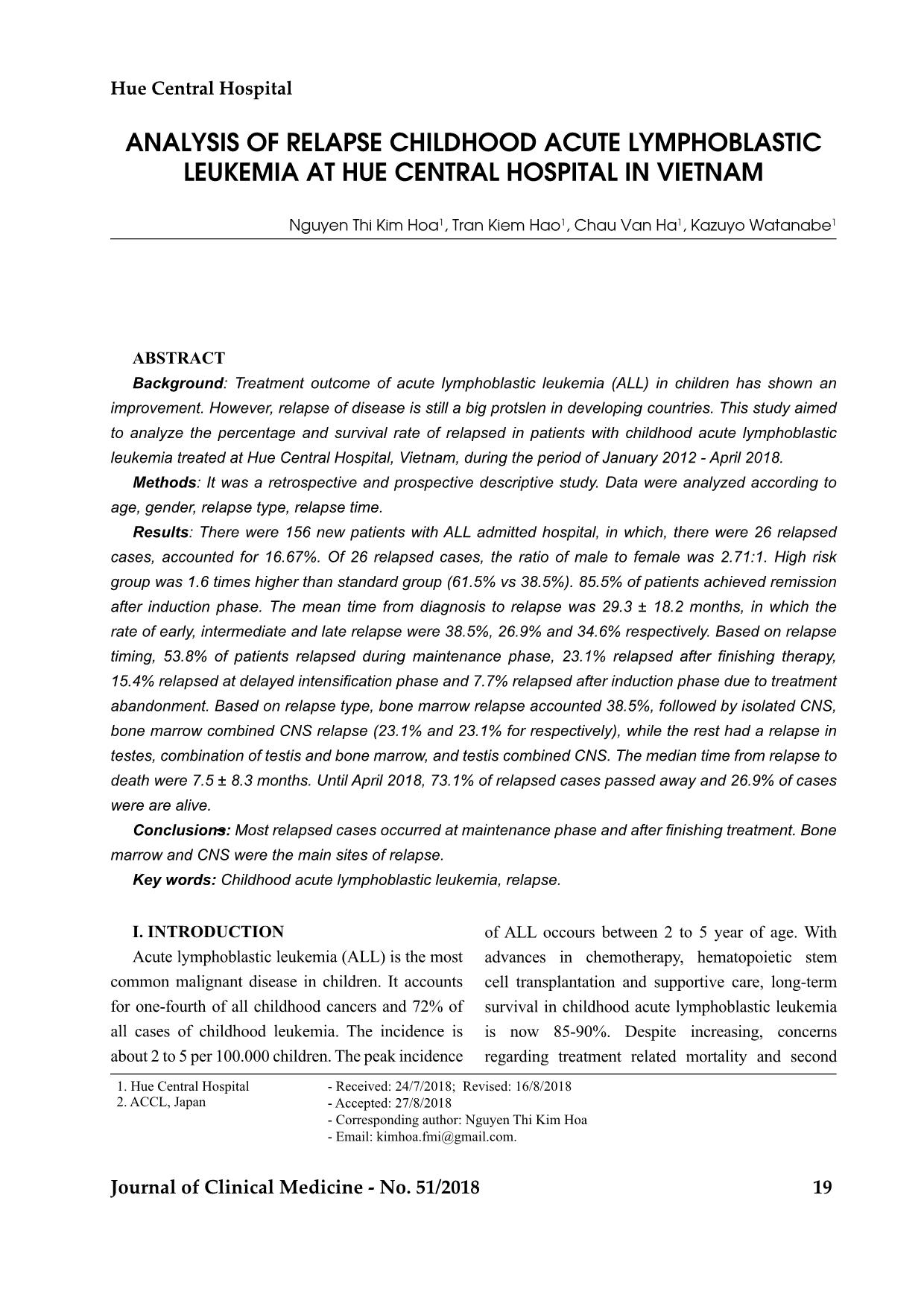
Trang 1
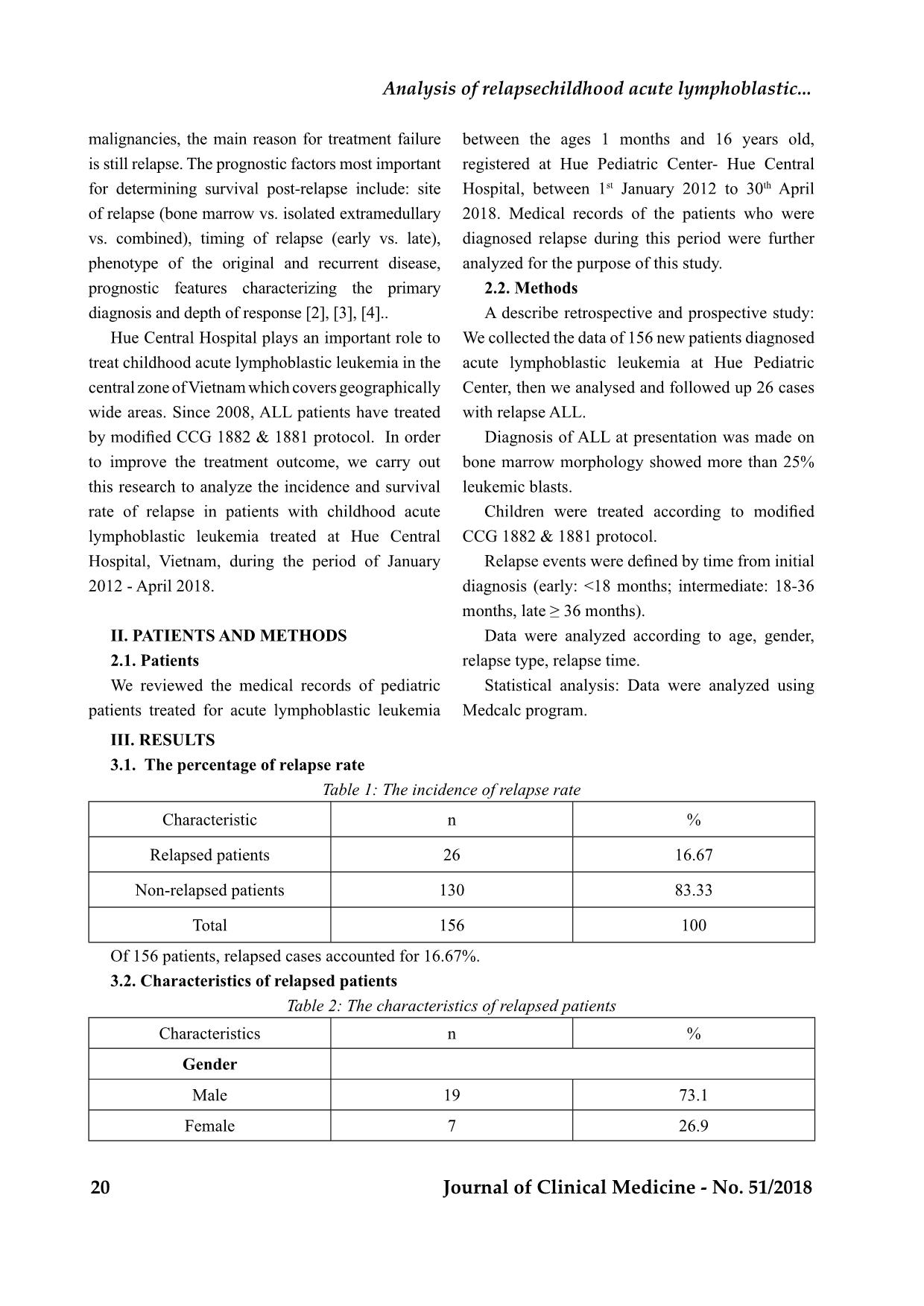
Trang 2
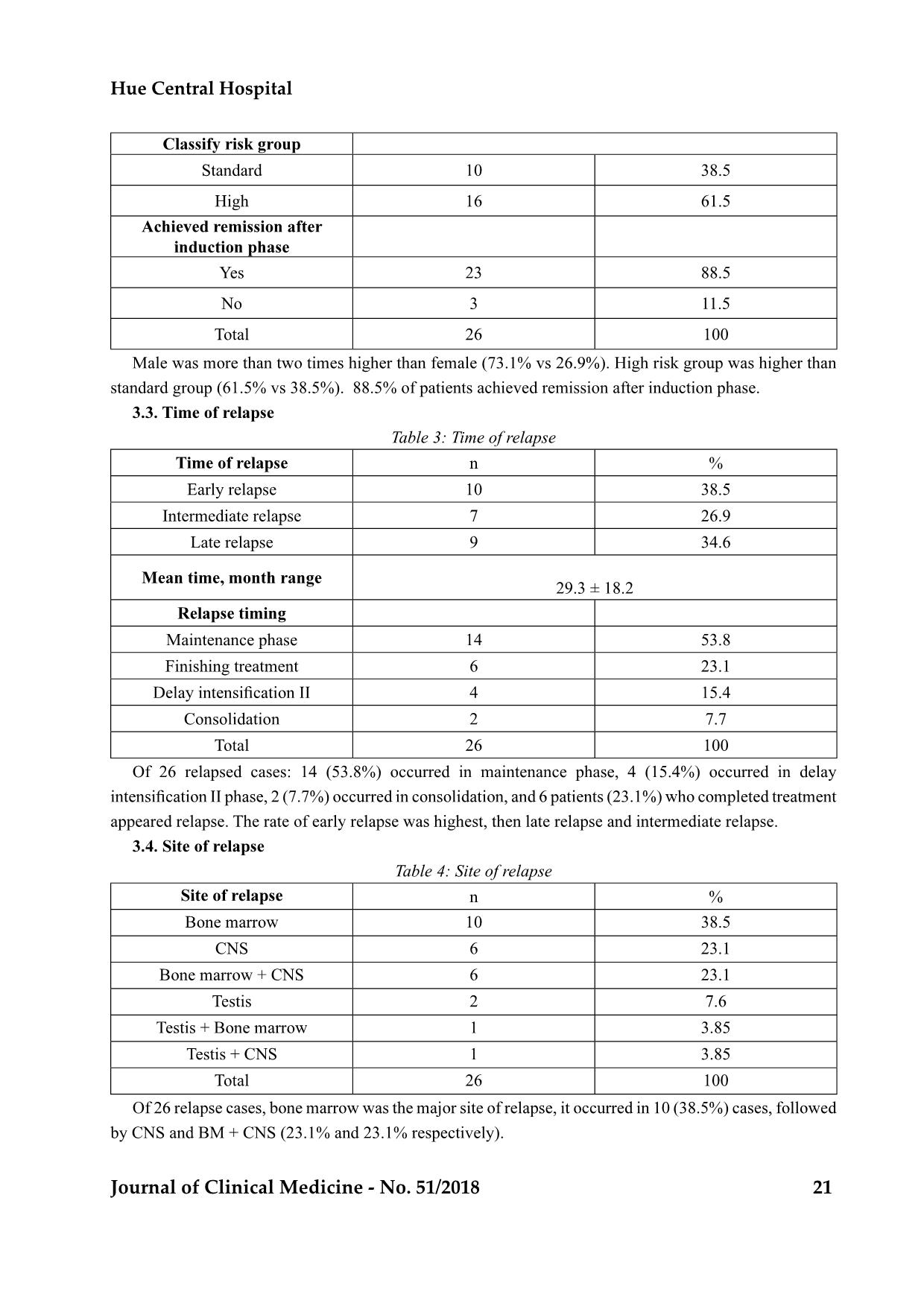
Trang 3
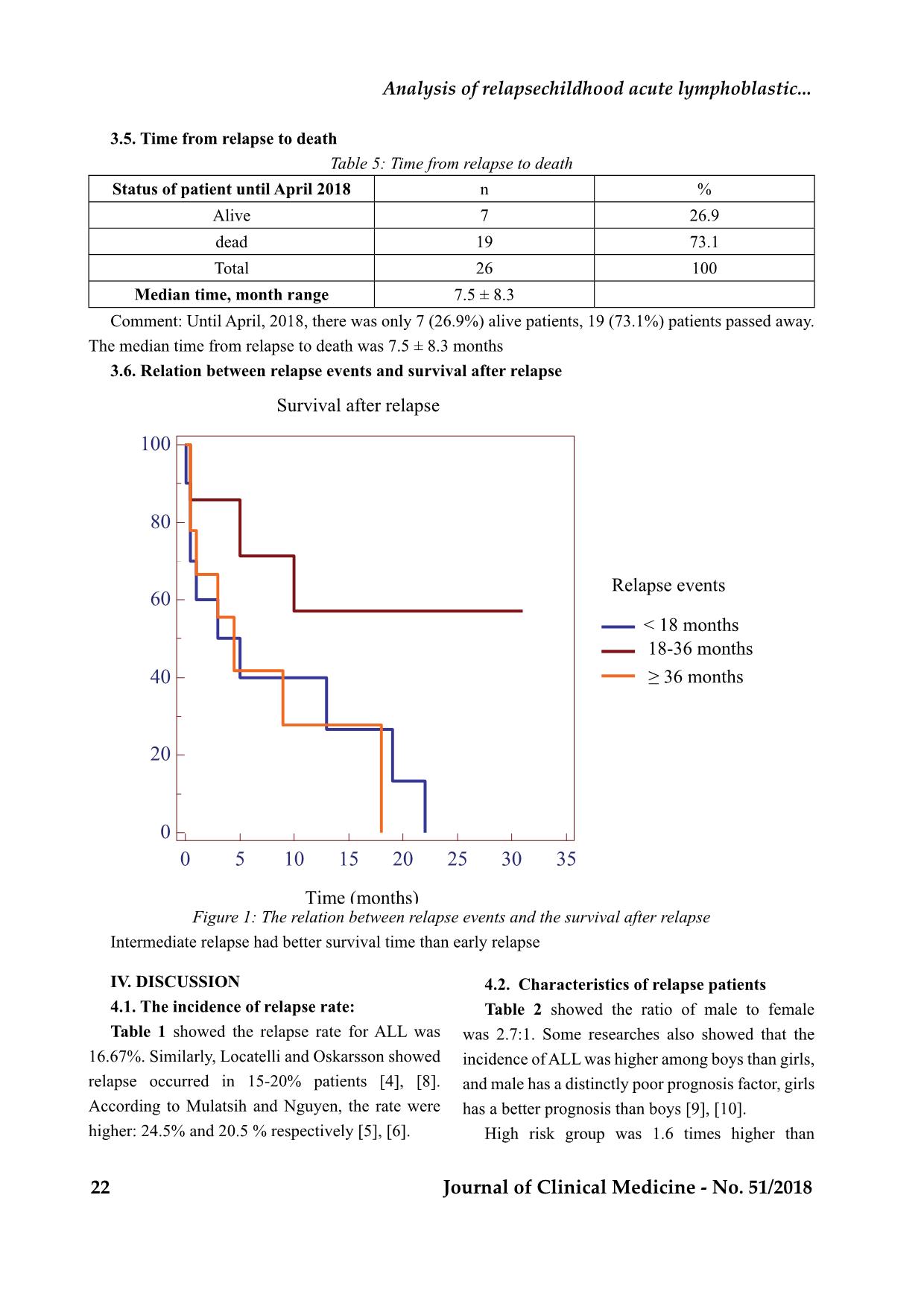
Trang 4
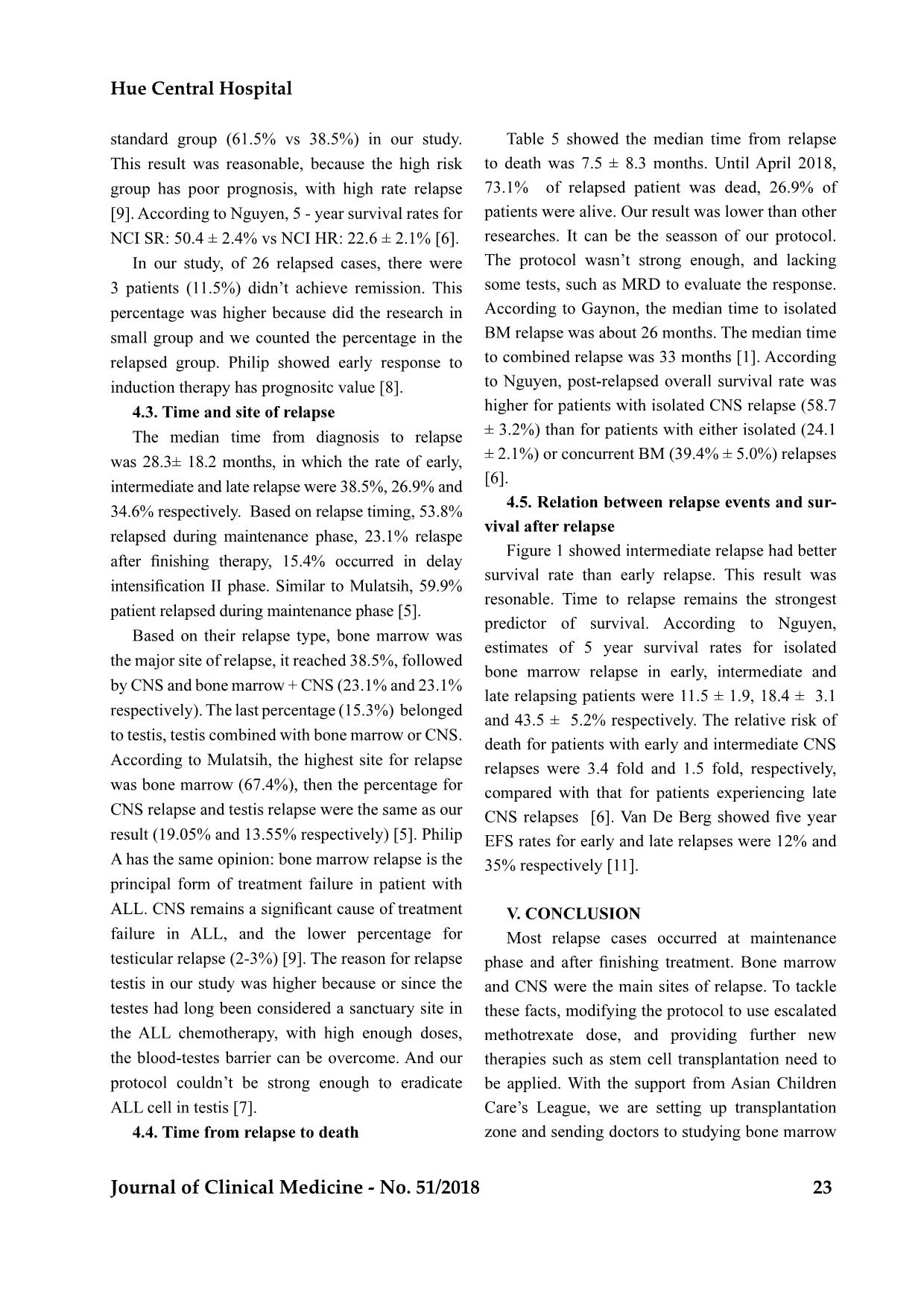
Trang 5
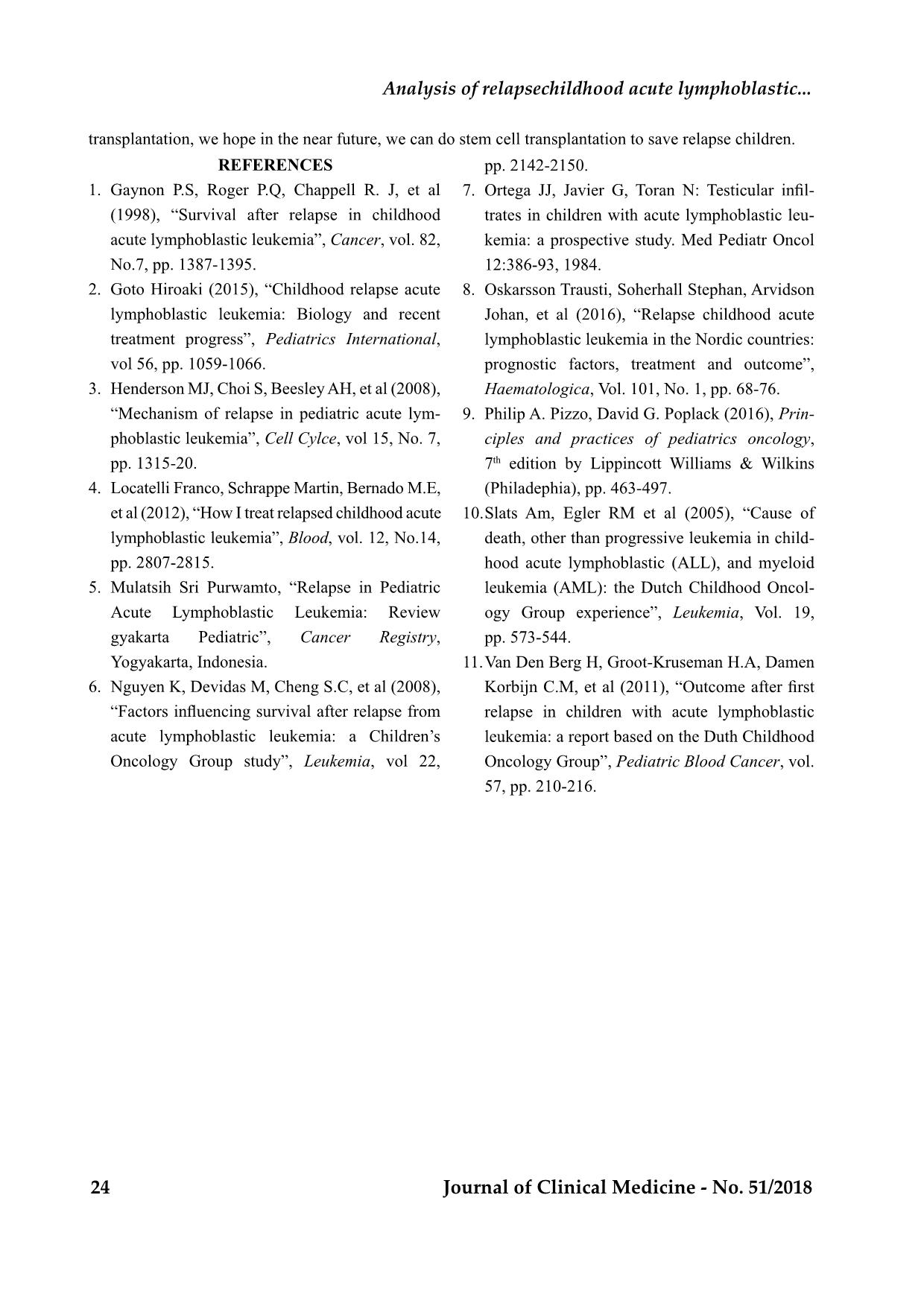
Trang 6
Bạn đang xem tài liệu "Analysis of relapse childhood acute lymphoblastic leukemia at hue central hospital in vietnam", để tải tài liệu gốc về máy hãy click vào nút Download ở trên
Tóm tắt nội dung tài liệu: Analysis of relapse childhood acute lymphoblastic leukemia at hue central hospital in vietnam
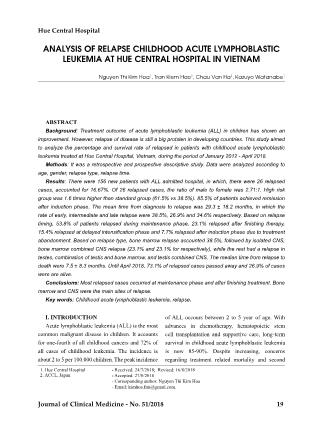
Hue Central Hospital Journal of Clinical Medicine - No. 51/2018 19 ANALYSIS OF RELAPSE CHILDHOOD ACUTE LYMPHOBLASTIC LEUKEMIA AT HUE CENTRAL HOSPITAL IN VIETNAM Nguyen Thi Kim Hoa1, Tran Kiem Hao1, Chau Van Ha1, Kazuyo Watanabe1 ABSTRACT Background: Treatment outcome of acute lymphoblastic leukemia (ALL) in children has shown an improvement. However, relapse of disease is still a big protslen in developing countries. This study aimed to analyze the percentage and survival rate of relapsed in patients with childhood acute lymphoblastic leukemia treated at Hue Central Hospital, Vietnam, during the period of January 2012 - April 2018. Methods: It was a retrospective and prospective descriptive study. Data were analyzed according to age, gender, relapse type, relapse time. Results: There were 156 new patients with ALL admitted hospital, in which, there were 26 relapsed cases, accounted for 16.67%. Of 26 relapsed cases, the ratio of male to female was 2.71:1. High risk group was 1.6 times higher than standard group (61.5% vs 38.5%). 85.5% of patients achieved remission after induction phase. The mean time from diagnosis to relapse was 29.3 ± 18.2 months, in which the rate of early, intermediate and late relapse were 38.5%, 26.9% and 34.6% respectively. Based on relapse abandonment. Based on relapse type, bone marrow relapse accounted 38.5%, followed by isolated CNS, bone marrow combined CNS relapse (23.1% and 23.1% for respectively), while the rest had a relapse in testes, combination of testis and bone marrow, and testis combined CNS. The median time from relapse to death were 7.5 ± 8.3 months. Until April 2018, 73.1% of relapsed cases passed away and 26.9% of cases were are alive. Conclusions: marrow and CNS were the main sites of relapse. Key words: Childhood acute lymphoblastic leukemia, relapse. I. INTRODUCTION Acute lymphoblastic leukemia (ALL) is the most common malignant disease in children. It accounts for one-fourth of all childhood cancers and 72% of all cases of childhood leukemia. The incidence is about 2 to 5 per 100.000 children. The peak incidence of ALL occours between 2 to 5 year of age. With advances in chemotherapy, hematopoietic stem cell transplantation and supportive care, long-term survival in childhood acute lymphoblastic leukemia is now 85-90%. Despite increasing, concerns regarding treatment related mortality and second 1. Hue Central Hospital 2. ACCL, Japan - Received: 24/7/2018; Revised: 16/8/2018 - Accepted: 27/8/2018 - Corresponding author: Nguyen Thi Kim Hoa - Email: kimhoa.fmi@gmail.com. T20 Journal of Clinical Medicine - No. 51/2018 malignancies, the main reason for treatment failure is still relapse. The prognostic factors most important for determining survival post-relapse include: site of relapse (bone marrow vs. isolated extramedullary vs. combined), timing of relapse (early vs. late), phenotype of the original and recurrent disease, prognostic features characterizing the primary diagnosis and depth of response [2], [3], [4].. Hue Central Hospital plays an important role to treat childhood acute lymphoblastic leukemia in the central zone of Vietnam which covers geographically wide areas. Since 2008, ALL patients have treated by CCG 1882 & 1881 protocol. In order to improve the treatment outcome, we carry out this research to analyze the incidence and survival rate of relapse in patients with childhood acute lymphoblastic leukemia treated at Hue Central Hospital, Vietnam, during the period of January 2012 - April 2018. II. PATIENTS AND METHODS 2.1. Patients We reviewed the medical records of pediatric patients treated for acute lymphoblastic leukemia between the ages 1 months and 16 years old, registered at Hue Pediatric Center- Hue Central Hospital, between 1st January 2012 to 30th April 2018. Medical records of the patients who were diagnosed relapse during this period were further analyzed for the purpose of this study. 2.2. Methods A describe retrospective and prospective study: We collected the data of 156 new patients diagnosed acute lymphoblastic leukemia at Hue Pediatric Center, then we analysed and followed up 26 cases with relapse ALL. Diagnosis of ALL at presentation was made on bone marrow morphology showed more than 25% leukemic blasts. CCG 1882 & 1881 protocol. diagnosis (early: <18 months; intermediate: 18-36 Data were analyzed according to age, gender, relapse type, relapse time. Statistical analysis: Data were analyzed using Medcalc program. III. RESULTS 3.1. The percentage of relapse rate Table 1: The incidence of relapse rate Characteristic n % Relapsed patients 26 16.67 Non-relapsed patients 130 83.33 Total 156 100 Of 156 patients, relapsed cases accounted for 16.67%. 3.2. Characteristics of relapsed patients Table 2: The characteristics of relapsed patients Characteristics n % Gender Male 19 73.1 Female 7 26.9 Hue Central Hospital Journal of Clinical Medicine - No. 51/2018 21 Standard 10 38.5 High 16 61.5 Yes 23 88.5 No 3 11.5 Total 26 100 standard group (61.5% vs 38.5%). 88.5% of patients achieved remission after induction phase. Table 3: Time of relapse n % Early relapse 10 38.5 Intermediate relapse 7 26.9 Late relapse 9 34.6 29.3 ± 18.2 Maintenance phase 14 53.8 Finishing treatment 6 23.1 4 15.4 Consolidation 2 7.7 Total 26 100 Of 26 relapsed cases: 14 (53.8%) occurred in maintenance phase, 4 (15.4%) occurred in delay Table 4: Site of relapse n % 10 38.5 CNS 6 23.1 6 23.1 Testis 2 7.6 1 3.85 Testis + CNS 1 3.85 Total 26 100 by CNS and BM + CNS (23.1% and 23.1% respectively). T22 Journal of Clinical Medicine - No. 51/2018 3.5. Time from relapse to death Table 5: Time from relapse to death Status of patient until April 2018 n % Alive 7 26.9 dead 19 73.1 Total 26 100 Median time, month range 7.5 ± 8.3 Comment: Until April, 2018, there was only 7 (26.9%) alive patients, 19 (73.1%) patients passed away. The median time from relapse to death was 7.5 ± 8.3 months 3.6. Relation between relapse events and survival after relapse Figure 1: The relation between relapse events and the survival after relapse Intermediate relapse had better survival time than early relapse Survival after relapse 0 5 10 15 20 25 30 35 0 20 40 60 80 100 Relapse events < 18 months 36 months Time (months) 18-36 months IV. DISCUSSION 4.1. The incidence of relapse rate: Table 1 showed the relapse rate for ALL was 16.67%. Similarly, Locatelli and Oskarsson showed relapse occurred in 15-20% patients [4], [8]. According to Mulatsih and Nguyen, the rate were higher: 24.5% and 20.5 % respectively [5], [6]. 4.2. Characteristics of relapse patients Table 2 showed the ratio of male to female was 2.7:1. Some researches also showed that the incidence of ALL was higher among boys than girls, and male has a distinctly poor prognosis factor, girls has a better prognosis than boys [9], [10]. High risk group was 1.6 times higher than Hue Central Hospital Journal of Clinical Medicine - No. 51/2018 23 standard group (61.5% vs 38.5%) in our study. [9]. According to Nguyen, 5 - year survival rates for NCI SR: 50.4 ± 2.4% vs NCI HR: 22.6 ± 2.1% [6]. 3 patients (11.5%) didn’t achieve remission. This induction therapy has prognositc value [8]. The median time from diagnosis to relapse ± 34.6% respectively. Based on relapse timing, 53.8% relapsed during maintenance phase, 23.1% relaspe patient relapsed during maintenance phase [5]. respectively). The last percentage (15.3%) belonged According to Mulatsih, the highest site for relapse result (19.05% and 13.55% respectively) [5]. Philip testicular relapse (2-3%) [9]. The reason for relapse testes had long been considered a sanctuary site in the blood-testes barrier can be overcome. And our protocol couldn’t be strong enough to eradicate ALL cell in testis [7]. researches. It can be the seasson of our protocol. some tests, such as MRD to evaluate the response. ± ± 2.1%) or concurrent BM (39.4% ± 5.0%) relapses [6]. resonable. Time to relapse remains the strongest predictor of survival. According to Nguyen, estimates of 5 year survival rates for isolated ± 1.9, 18.4 ± 3.1 and 43.5 ± 5.2% respectively. The relative risk of 35% respectively [11]. Most relapse cases occurred at maintenance these facts, modifying the protocol to use escalated therapies such as stem cell transplantation need to be applied. With the support from Asian Children T24 Journal of Clinical Medicine - No. 51/2018 REFERENCES 1. Gaynon P.S, Roger P.Q, Chappell R. J, et al (1998), “Survival after relapse in childhood acute lymphoblastic leukemia”, Cancer, vol. 82, No.7, pp. 1387-1395. 2. Goto Hiroaki (2015), “Childhood relapse acute lymphoblastic leukemia: Biology and recent treatment progress”, Pediatrics International, vol 56, pp. 1059-1066. 3. Henderson MJ, Choi S, Beesley AH, et al (2008), “Mechanism of relapse in pediatric acute lym- phoblastic leukemia”, Cell Cylce, vol 15, No. 7, pp. 1315-20. 4. Locatelli Franco, Schrappe Martin, Bernado M.E, et al (2012), “How I treat relapsed childhood acute lymphoblastic leukemia”, Blood, vol. 12, No.14, pp. 2807-2815. 5. Mulatsih Sri Purwamto, “Relapse in Pediatric Acute Lymphoblastic Leukemia: Review gyakarta Pediatric”, Cancer Registry, Yogyakarta, Indonesia. 6. Nguyen K, Devidas M, Cheng S.C, et al (2008), acute lymphoblastic leukemia: a Children’s Oncology Group study”, Leukemia, vol 22, pp. 2142-2150. 7. - trates in children with acute lymphoblastic leu- kemia: a prospective study. Med Pediatr Oncol 12:386-93, 1984. 8. Oskarsson Trausti, Soherhall Stephan, Arvidson Johan, et al (2016), “Relapse childhood acute lymphoblastic leukemia in the Nordic countries: prognostic factors, treatment and outcome”, Haematologica, Vol. 101, No. 1, pp. 68-76. 9. Philip A. Pizzo, David G. Poplack (2016), Prin- ciples and practices of pediatrics oncology, 7th edition by Lippincott Williams & Wilkins (Philadephia), pp. 463-497. 10. Slats Am, Egler RM et al (2005), “Cause of death, other than progressive leukemia in child- hood acute lymphoblastic (ALL), and myeloid leukemia (AML): the Dutch Childhood Oncol- ogy Group experience”, Leukemia, Vol. 19, pp. 573-544. 11. Van Den Berg H, Groot-Kruseman H.A, Damen relapse in children with acute lymphoblastic leukemia: a report based on the Duth Childhood Oncology Group”, Pediatric Blood Cancer, vol. 57, pp. 210-216. transplantation, we hope in the near future, we can do stem cell transplantation to save relapse children.
File đính kèm:
 analysis_of_relapse_childhood_acute_lymphoblastic_leukemia_a.pdf
analysis_of_relapse_childhood_acute_lymphoblastic_leukemia_a.pdf

